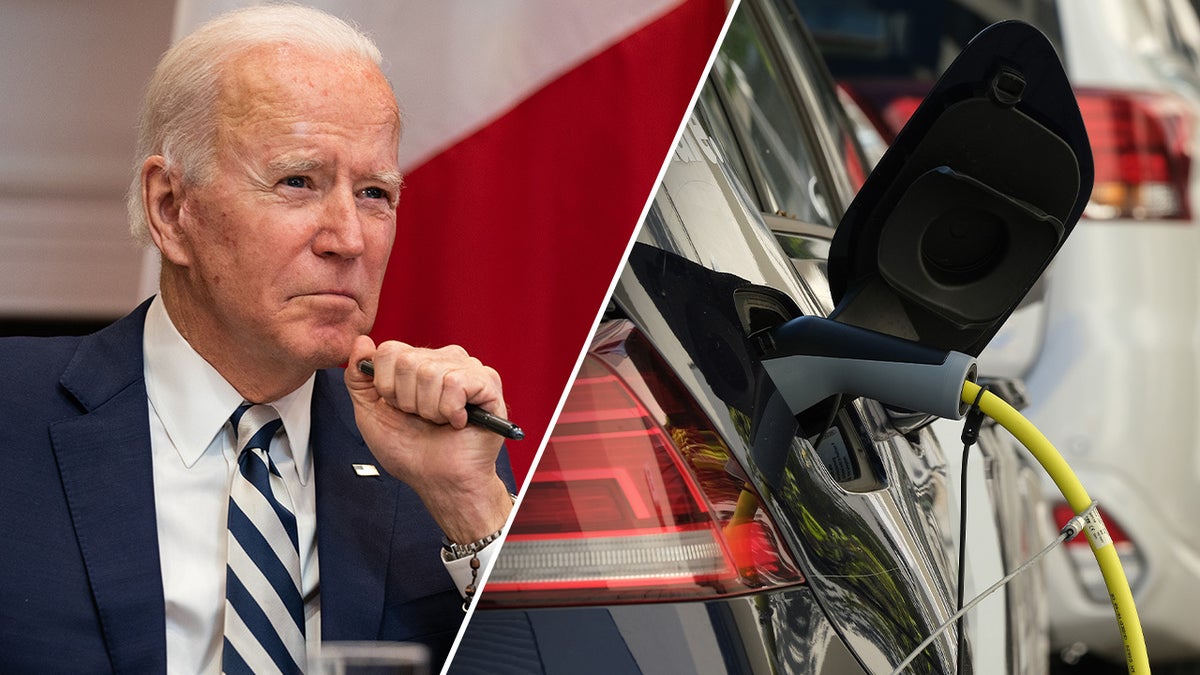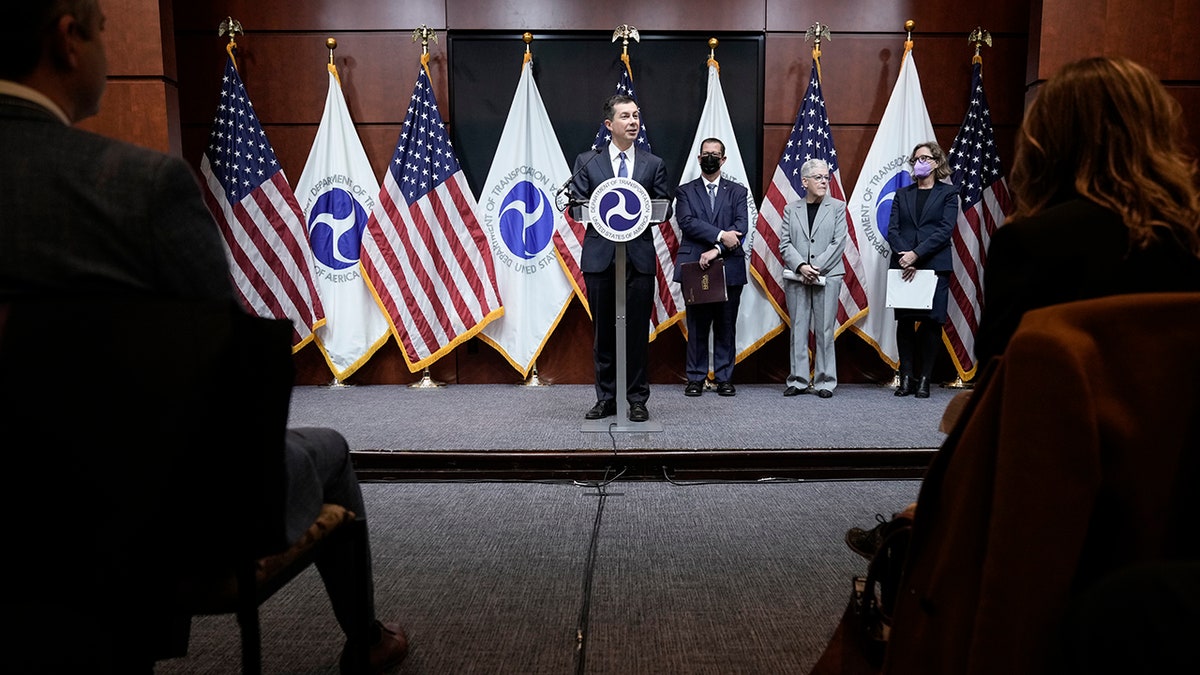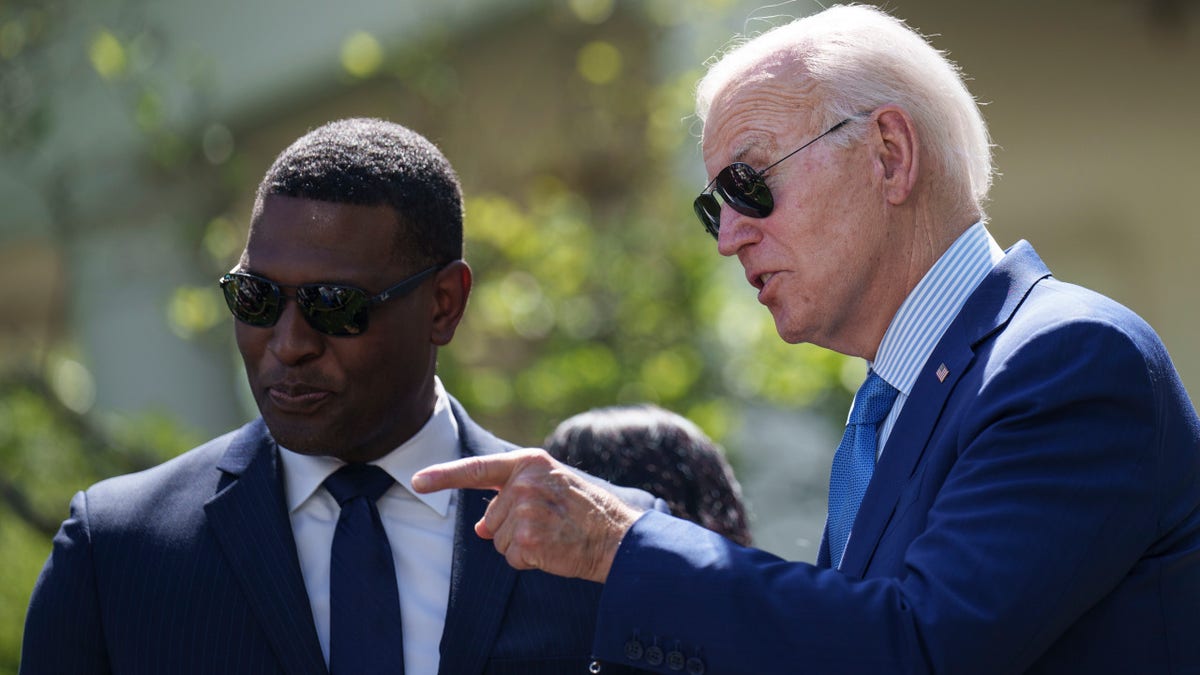The Biden administration is facing an onslaught of opposition to its proposed fuel economy standards, which critics say would increase consumer costs and unfairly burden U.S. businesses.
Get your TRUMP 2024 Mug Shot Gear here!
The Department of Transportation's National Highway Traffic Safety Administration (NHTSA) received more than 62,900 public comments related to the fuel economy regulations it issued in late July during its comment period, which ended Monday. The so-called Corporate Average Fuel Economy (CAFE) standards received opposition letters from a wide range of stakeholders, including 26 states and the energy, agriculture and automotive industries.
"NHTSA’s proposal is yet another attempt by the Biden administration to restrict Americans’ freedom to decide what vehicle fits their needs and budget," Will Hupman, the American Petroleum Institute's (API) vice president of downstream policy, said in a statement.
"Combined with EPA’s proposed tailpipe emissions standards, these rules amount to a de facto ban on cars and trucks using liquid fuels, which can and should be a part of the solution to reduce carbon emissions," he continued.

President Biden previously set a goal of ensuring 50% of car purchases are electric by 2030. His administration has since pushed aggressive tailpipe emissions regulations and fuel economy standards to incentivize greater electric vehicle purchases. (Anna Moneymaker/Pool/Getty Images | Sean Gallup/Getty Images)
Get your TRUMP 2024 Mug Shot Gear here!
API argued in its comment letter to NHTSA that, while it supports policies to lower drive greenhouse gas (GHG) emissions in the transportation sector, the proposed fuel economy standards would harm consumer choice, raise costs and create a non-resilient transport sector that is "vulnerable to unexpected disruptions" since it would be dependent on electric vehicles.
The group, which is the nation's largest fossil fuel lobby organization, also argued NHTSA lacks the authority to implement regulations that "effectively require electrification" of a portion of the U.S. vehicle fleet.
STUDY CASTS DOUBT ON ELECTRIC VEHICLES' CLIMATE, COST BENEFITS: 'WON'T ACHIEVE THE GOALS INTENDED'
"NHTSA has departed from Congressional intent and proposed standards that do not meet statutory requirements," American Fuel & Petrochemical Manufacturers, another industry group, wrote in a comment letter. "In particular, we believe that NHTSA exceeds its legal authority by setting the fuel economy standards at a level that is not feasibly achievable by internal combustion engine vehicles, effectively establishing a de facto electric vehicle mandate."
Get your TRUMP 2024 Mug Shot Gear here!
NHTSA's proposed CAFE standards, which the Biden administration argued would help combat climate change and save Americans money, require passenger cars and light trucks to improve fuel efficiency 2% and 4%, respectively, beginning in 2027. Under the rules, pickup trucks and work vans must boost fuel efficiency 10% every year starting in 2030.
By 2032, the agency said average U.S. fleet fuel economy could reach 58 miles per gallon. According to the Environmental Protection Agency, the estimated average fuel economy for model year 2022 cars was 26.4 miles per gallon, meaning the proposed standards would mandate automakers more than double fuel efficiency in less than a decade or face substantial penalties.

Hummer EVs are seen on the production line during President Biden's visit to the General Motors 'Factory ZERO' electric vehicle assembly plant in Detroit on Nov. 17, 2021. GM was one of dozens of major stakeholders to write to the administration expressing concern about the NHTSA proposal. (REUTERS/Jonathan Ernst/File Photo)
"Ford has never paid civil penalties under the CAFE program, and yet by NHTSA’s own analysis Ford would likely pay $1 billion in civil penalties if NHTSA’s Proposal were finalized," Ford Motor Company wrote in its comment letter. "This is alarming in and of itself, and threatens substantial economic hardship for Ford."
Get your TRUMP 2024 Mug Shot Gear here!
"Under NHTSA’s Proposal, automakers face risks of substantial civil penalties not because they are less capable than others, but because they hold a major portion of the market share for light-duty trucks," the major U.S. automaker continued. "Money paid in civil penalties could instead be invested toward the transition to EVs, toward higher wages for workers, or toward any number of virtuous policy objectives."
MORE THAN 150 REPUBLICANS UNITE TO CONDEMN BIDEN'S 'ILL-CONSIDERED' ELECTRIC VEHICLE PUSH
Ford's letter added that the payment of civil penalties serves no "policy objectives." The company also noted that, while it is projected to pay $1 billion in fines under the proposal, General Motors and Stellantis, the two other major American car brands, face much higher civil penalties.
By comparison, in the entire history of the CAFE program, according to Ford, the total civil penalties paid for light-duty fleets amounts to less than $1.5 billion.
Get your TRUMP 2024 Mug Shot Gear here!
"NHTSA's proposed CAFE rule… cannot be met even with a dramatic increase in electrification and a fleet that is compliant with EPAs proposed rule," Stellantis wrote in a separate letter. "The proposed rule is both impractical and works against industry, agency and administration electrification goals."

Transportation Secretary Pete Buttigieg speaks during an event about fuel economy standards alongside other top administration officials, including NHTSA Acting Administrator Ann Carlson. (Drew Angerer/Getty Images)
According to the Alliance for Automotive Innovation (AAI), an industry group which represents many major automakers, companies will pay more than $14 billion in non-compliance penalties under the proposal, impacting one in every two light trucks in 2027-2032, and one in every three passenger cars in 2027-2029. Overall, car prices are expected to increase by thousands of dollars.
Get your TRUMP 2024 Mug Shot Gear here!
"The number of non-compliant vehicles and manufacturers projected exceeds reason and will increase costs to the American consumer with absolutely no environmental or fuel savings benefits," the group wrote in its comment letter to NHTSA. "The projected $3,000 average price increase over today’s vehicles is likely to decrease sales and increase the average age of vehicles on our roads."
In addition, the group, echoing other industry organizations and stakeholders, said the NHTSA fuel economy standards should better align with tailpipe emissions rules issued by the EPA.
TOP REPUBLICANS LAUNCH PROBE INTO LEONARDO DICAPRIO-FUNDED BLUE STATE LAWSUITS AGAINST BIG OIL
"Automakers can ill afford to make the investments necessary to reach the Biden Administration’s goal of 50% EV sales by 203012 while also making major investments in internal combustion engine (ICE) vehicles," the AAI continued in its letter.
Get your TRUMP 2024 Mug Shot Gear here!
"Unlike the past, where profits from existing ICE vehicles funded investments in the next generation of ICE vehicles, it is generally understood that (for legacy automakers) profits from ICE vehicles will be used to fund the transition to electric vehicles," it continued. "Nor can automakers afford to pay billions of dollars in civil penalties for non-compliance with CAFE regulations while still complying with EPA GHG regulations."

President Biden talks to EPA Administrator Michael Regan during a White House event on environmental justice earlier this year. (Drew Angerer/Getty Images)
NHTSA proposed its regulations just three months after the EPA proposed the most aggressive tailpipe emissions ever crafted, which it said would cause 67% of new sedan, crossover, SUV and light truck purchases to be electric by 2032.
West Virginia Attorney General Patrick Morrisey led a coalition of 26 states in writing a letter opposing NHTSA's rules. The states argued the agency overstepped its legal authority in issuing the regulations which they further said would threaten national security and place an overwhelming stress on the power grid.
Get your TRUMP 2024 Mug Shot Gear here!
"Our power grid — already stretched thin by increasing electrification across all sectors and other governmental action — could not handle the massive predicted uptick in EVs. And even if it could, we don’t have the supply chains to make that manufacturing increase feasible," Morrisey and the other state attorneys general wrote.
"At a minimum, U.S. manufacturers will have no option but to become embroiled with geopolitically troubling suppliers," they continued. "The Proposed Rule cannot explain how our energy and manufacturing infrastructures will handle the EV wave it wants to create."
Source: https://www.foxnews.com/politics/biden-admin-faces-pressure-drop-electric-vehicle-mandate-regulations-alarming






